Sexing Cichlasoma festae
Ok this is just a short little article to help anybody out that's having
trouble sexing there Festaes, and also because i love writing articles
about this awesome fish. Firstly i wanted to add that this particular species
of Cichlid isn't like most other cichlids in the way that the Female is
normally a lot more colourfull than the male. But the main differences
between male and female Festae is the black/blue markings on there dorsal
and pelvic fins, there is also the matter of the blue spangling dots on
the males fins and tail end of his body. Though there is some confusion
in using this particular trait in sexing males as in some festae populations
females may also obtain the blue spangling though it is normally to a much
lesser degree. Anyway here are some pictures, unfortunately there aren't
to many photos of male Festaes on the net as like i mentioned before the
females are much more colourfull and hence create much nicer pictures.
This isn't however to say male Festaes are ugly or dull, it's just the
Red colour isn't as intense as in the Female.
Here are some males.
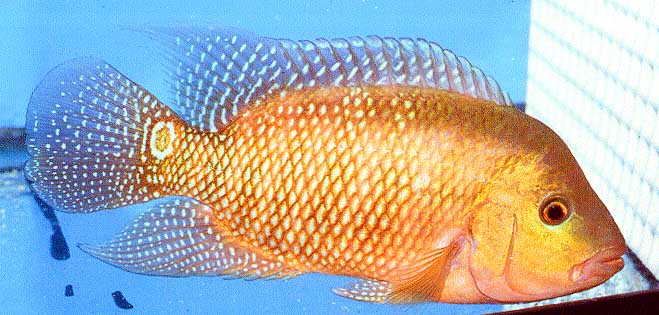 Photo from Tangled
Up in Cichlids, by Jeff Rapps
As you can see by this photo especially this male Festae is definitely
not dull or lacking in colour, however you will notice the gold colour
instead of the Red, males generally obtain a yellow, green or gray colour.
Can you see he has no black dorsal or pelvic fins and the spots
extend well up his body, this is a real stunner of a male, if you interested
in buying quality Cichlids like the beautiful male please have a look at
Jeff Rapps Tangled Up in Cichlids
page.
Photo from Tangled
Up in Cichlids, by Jeff Rapps
As you can see by this photo especially this male Festae is definitely
not dull or lacking in colour, however you will notice the gold colour
instead of the Red, males generally obtain a yellow, green or gray colour.
Can you see he has no black dorsal or pelvic fins and the spots
extend well up his body, this is a real stunner of a male, if you interested
in buying quality Cichlids like the beautiful male please have a look at
Jeff Rapps Tangled Up in Cichlids
page.
 Photo from Real
Cichlids Eat Quiche
This is an average looking male, but you can notice the lack
of a black dorsal and pelvic fins, you can also see his tube, see
how it's thin, a females is a lot fatter, generally a male will have his
tube out a lot of the time.
Photo from Real
Cichlids Eat Quiche
This is an average looking male, but you can notice the lack
of a black dorsal and pelvic fins, you can also see his tube, see
how it's thin, a females is a lot fatter, generally a male will have his
tube out a lot of the time.
 Photo from Big Fish,
by Tim Bardsley - Smith
This is my magnificent male, isn't he cool. To show you how much
he coloured up in the 6" to 9" period have a look at the male above, that's
what this one looked like at 6". see the blue dots??. and no black dorsal.
Photo from Big Fish,
by Tim Bardsley - Smith
This is my magnificent male, isn't he cool. To show you how much
he coloured up in the 6" to 9" period have a look at the male above, that's
what this one looked like at 6". see the blue dots??. and no black dorsal.
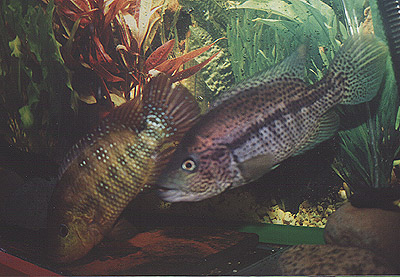 Photo from Big Fish,
by Tim Bardsley - Smith
Here is my male Festae again unfortunately it's a little
dark but you can see the blue dots, easy and you get to see my male Dovii.
The Dovii normally looks a lot nicer, his fins are usually bright blue/green.
Photo from Big Fish,
by Tim Bardsley - Smith
Here is my male Festae again unfortunately it's a little
dark but you can see the blue dots, easy and you get to see my male Dovii.
The Dovii normally looks a lot nicer, his fins are usually bright blue/green.
Here are Some females
 Photo from Real
Cichlids Eat Quiche
Here is a nice female, notice the dark dorsal and the lack of blue
spots.
Photo from Real
Cichlids Eat Quiche
Here is a nice female, notice the dark dorsal and the lack of blue
spots.
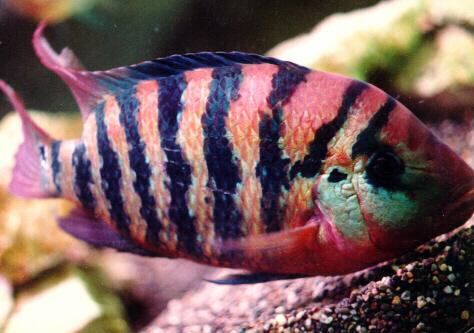 Photo from Real
Cichlids Eat Quiche
This female is showing her black bars, females normally do this
a lot more than the males do, and keep the bars through there courting,
breeding and raising periods. They sometimes will show there bars when
not doing these as well. Males generally only show there bars when courting
or attacking something.
Photo from Real
Cichlids Eat Quiche
This female is showing her black bars, females normally do this
a lot more than the males do, and keep the bars through there courting,
breeding and raising periods. They sometimes will show there bars when
not doing these as well. Males generally only show there bars when courting
or attacking something.
 Photo Unknown
This is a rather small photo but it shows how different each festae
can look, see the blue dorsal instead of black.
This is due to different populations of Festaes, and hence there
are differences
Photo Unknown
This is a rather small photo but it shows how different each festae
can look, see the blue dorsal instead of black.
This is due to different populations of Festaes, and hence there
are differences
 Photo from Real
Cichlids Eat Quiche
This photo is rather dark but you can see her dark dorsal and blue
pelvic fins.
Photo from Real
Cichlids Eat Quiche
This photo is rather dark but you can see her dark dorsal and blue
pelvic fins.
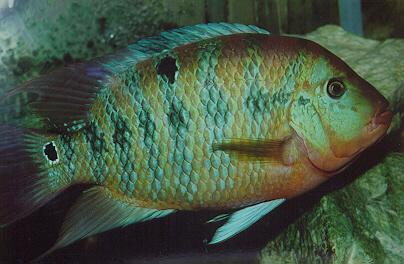 Photo from Real
Cichlids Eat Quiche
This is a big female again see how some festaes can have a very
Blue look, my Female had a blue colouration when she was stressed.
Photo from Real
Cichlids Eat Quiche
This is a big female again see how some festaes can have a very
Blue look, my Female had a blue colouration when she was stressed.
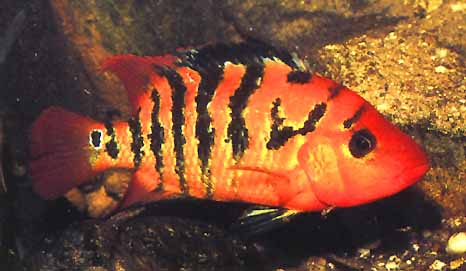 Photo Unknown
This is a very bright orange female. you can clearly see the black
dorsal and black pelvic fins. and again no blue spots.
Photo Unknown
This is a very bright orange female. you can clearly see the black
dorsal and black pelvic fins. and again no blue spots.
 Photo Unknown
Here is another Festae with blue markings instead of black, this
one also has a lot of red though.
Photo Unknown
Here is another Festae with blue markings instead of black, this
one also has a lot of red though.
 Photo Unknown
Here is a rather ordinary female, but you can see the black dorsal
and the lack of Blue spots.
Photo Unknown
Here is a rather ordinary female, but you can see the black dorsal
and the lack of Blue spots.
 Photo from JAWS
This photo originally confused me greatly, as up until the other
day i would have said it was a male, because of the blue spots, but
then it also had the black dorsal. So i asked a very knowledgeable Jeff
Rapps about it, and he told me some in populations of festae, the female
can also obtain the blue spangling, but never will a male get a Black dorsal.
therefore this has to be a female, this is also enforced by the bright
orange colour which would be unusual for a male Festae.
Photo from JAWS
This photo originally confused me greatly, as up until the other
day i would have said it was a male, because of the blue spots, but
then it also had the black dorsal. So i asked a very knowledgeable Jeff
Rapps about it, and he told me some in populations of festae, the female
can also obtain the blue spangling, but never will a male get a Black dorsal.
therefore this has to be a female, this is also enforced by the bright
orange colour which would be unusual for a male Festae.
 Photo from Tangled
Up in Cichlids, by Jeff Rapps
Here is another one of Jeff's Festaes, see how this female also
has some blue spangling.
Photo from Tangled
Up in Cichlids, by Jeff Rapps
Here is another one of Jeff's Festaes, see how this female also
has some blue spangling.
Well i hoped you like this short little article which turned out to
be more of a festae gallery but at least now you will know what too look
for when sexing you Festae. If you ever have any questions about this article
or on sexing your festae please email me at bigguapote@hotmail.com
By Tim Bardsley - Smith
I would like to thank my mate Simon for scanning the pictures of my
male Festae.














